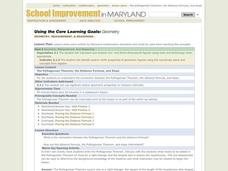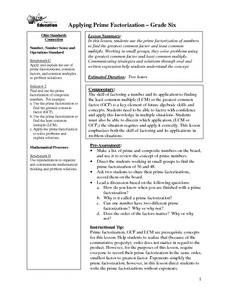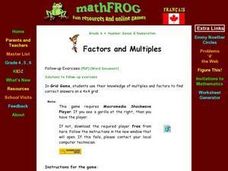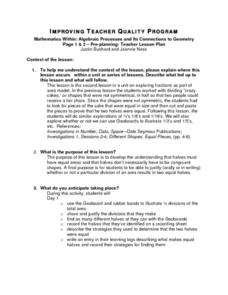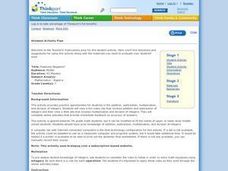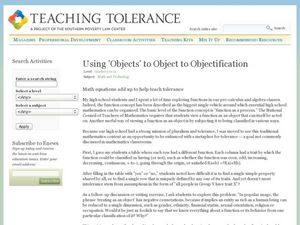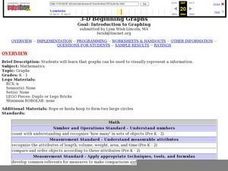Curated OER
The Pythagorean Theorem, the Distance Formula, and Slope
Students explore the concept of the Pythagorean Theorem. For this Pythagorean Theorem lesson, students derive the distance formula and slope of a line from the Pythagorean Theorem.
Curated OER
Commutative Property
First graders use various models to learn the Commutative Property of Addition. In this Commutative Property instructional activity, 1st graders use other students, counters, balances, and dominoes to apply the addition property....
Curated OER
Area of Irregular Polygons
In this geometry worksheet, 10th graders determine the area of irregular polygons. The one page worksheet contains three problems. Solutions are provided.
Curated OER
Applying Prime Factorization
Sixth graders use the prime factorization of numbers to find the greatest common factor and least common multiple. Working in small groups, they solve problems using the greatest common factor and least common multiple.
Curated OER
Factors and Multiples
Sixth graders need to see the relevance in the mathematics they learn. This lesson builds on the concepts of least common multiple and greatest common factor. The lesson presents real-world problem situations for students to solve.
Curated OER
Multiplication: Building Models, Representations and Explanations
First graders explore multiplication concepts through skip counting, repeated addition and arrays. Using animal characteristics as a context, 1st graders solve problems using mathematical tools such as hundreds charts, number lines, ...
Curated OER
Fractions and Halves
Fourth graders examine halves of a whole and discover through activities that they must be exactly equal in size. Working with Geoboards and Dot-Paper Squares, the class practices finding halves that are both congruent and incongruent.
Curated OER
Positively Negative?
Students practice the addition, subtraction, multiplication, and division of integers. They view a video clip on addition and subtraction of integers. Students observe a Web site that reviews multiplication and division of integers....
Curated OER
Function Investigation
In this functions activity, 11th graders solve and complete 18 different problems. First, they graph each equation on the graphs provided, making a rough sketch on a coordinate plane. Then, students predict what each graph will look like...
Alabama Learning Exchange
Ellipse
Students explore the concept of ellipses. In this ellipses lesson, they construct ellipses on their paper and follow directions on a worksheet that allow them to investigate an ellipse in more depth by looking at the major axis, foci, etc.
Curated OER
Talk the Talk
Students interactively learn multimedia terminology while using the Alice Programming. In this multimedia lesson students become the director of a movie or video game.
Curated OER
Using Objects to Object to Objectification
Students use math functions in part to complete a metaphorical lesson on tolerance. In this math and tolerance lesson, students receive rows of functions and try to find a single simple shared property without success. Students then...
Curated OER
Turtle Tales
Young scholars watch videos and fill out worksheets about the turtles and their journey to the Costa Rican beach. In this turtles lesson plan, students learn and discuss survival, predator and prey, and stages of development.
Curated OER
Graphing Inequalities
Young scholars graph linear equations and then find the person in class whose linear equation graph is perpendicular to theirs. In this graphing inequalities lesson plan, students graph their perpendicular slopes and then once their find...
Curated OER
Identities and Trigonometric Values
Students solve trigonometric equations. In this precalculus lesson, students prove trigonometric identities using the Pythagorean Theorem. They apply the addition formulas for sine and cosine to prove different identities.
Curated OER
Learning by Sorting
Students sort Lego Duplo pieces after determining the attributes to classify them by. They work in pairs to sort a group of Duplo pieces and explain their process to others.
Curated OER
3-D Beginning Graphs
Students explore the concept of big and small. They collect objects from the classroom, sort them by size, and create a graph using Duplo stacking blocks.
Curated OER
Line Of Best Fit: Feet & Forearms
High schoolers actively find the line of best fit. They gather their own data and then use a calculator to find the line of best fit, as well as the equation. They see how to use the TI 81 calculator in order to find the line of best fit.
Curated OER
Introduction to Plates, Axles, and Gears
Learners are introduced to the function and design of the following Lego pieces: beams, bricks, plates, axles, tires, hubs and bushings. They then work with a partner to build something using only these pieces.
Curated OER
Mathematics
Twelfth graders explore a variation of proof. In this geometry lesson, 12th graders apply their knowledge of proof to different scenario. They use 3 different tiers to advance through the lesson.
Curated OER
Error Correction Worksheet
In this error correction worksheet, students analyze 22 sentences which may contain errors in grammar. Students decide if there are mistakes and correct them.
Other popular searches
- Pre Algebra Projects
- Math Lessons Pre Algebra
- Pre Algebra Worksheets
- Pre Algebra Worksheets
- Pre Algebra Patterns
- Pre Algebra Assessment
- Pre Algebra Equations
- 5th Grade Pre Algebra
- Pre Algebra Probability
- Pre Algebra Review
- Pre Algebra Math Puzzles
- Pre Algebra Games


